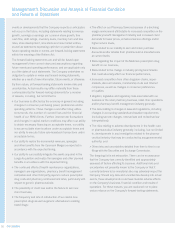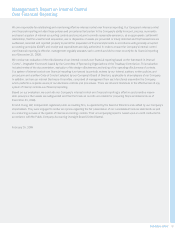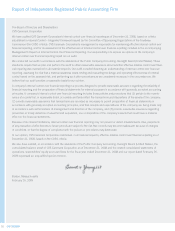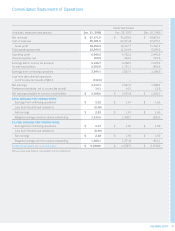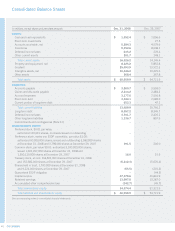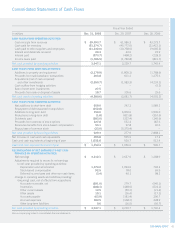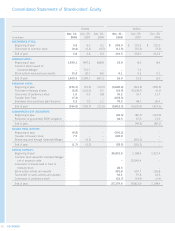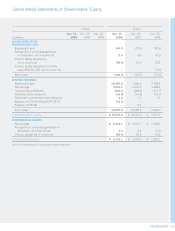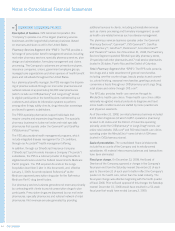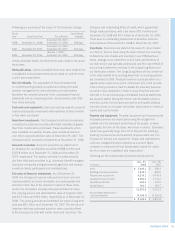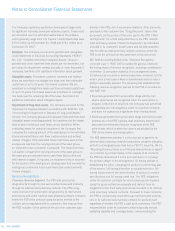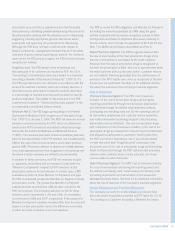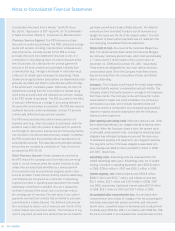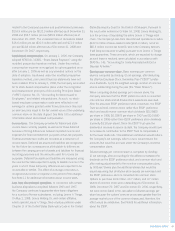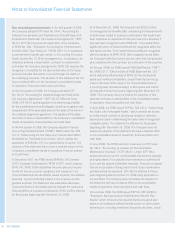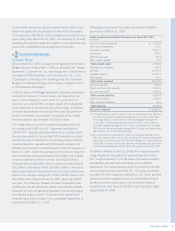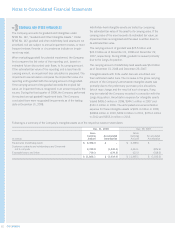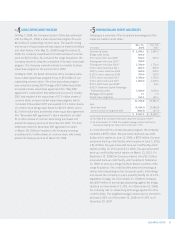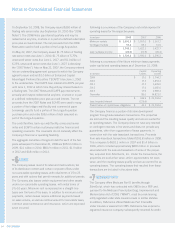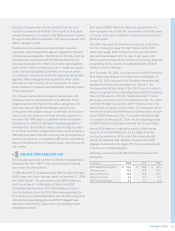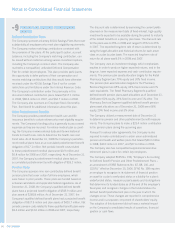CVS 2008 Annual Report Download - page 50
Download and view the complete annual report
Please find page 50 of the 2008 CVS annual report below. You can navigate through the pages in the report by either clicking on the pages listed below, or by using the keyword search tool below to find specific information within the annual report.
46 CVS CAREMARK
Notes to Consolidated Financial Statements
directly to the PSS, net of any volume-related or other discounts
paid back to the customer (see “Drug Discounts” later in this
document), (ii) the portion of the price paid to the PSS (“Mail
Co-Payments”) or a third party pharmacy in the PSS’ national
retail pharmacy network (“Retail Co-Payments”) by individuals
included in its customers’ benefi t plans and (iii) administrative
fees for national retail pharmacy network contracts where the
PSS is not the principal as discussed later in this document.
SEC Staff Accounting Bulletin 104, “Revenue Recognition,
corrected copy” ( “SAB 104”) provides the general criteria for
the timing aspect of revenue recognition, including consideration
of whether: (i) persuasive evidence of an arrangement exists,
(ii) delivery has occurred or services have been rendered, (iii) the
seller’s price to the buyer is fi xed or determinable and (iv) collect-
ability is reasonably assured. The Company has established the
following revenue recognition policies for the PSS in accordance
with SAB 104:
• Revenues generated from prescription drugs sold by mail
service pharmacies are recognized when the prescription is
shipped. At the time of shipment, the Company has performed
substantially all of its obligations under its customer contracts
and does not experience a signifi cant level of reshipments.
• Revenues generated from prescription drugs sold by third party
pharmacies in the PSS’ national retail pharmacy network and
associated administrative fees are recognized at the PSS’
point-of-sale, which is when the claim is adjudicated by the
PSS’ online claims processing system.
The PSS determines whether it is the principal or agent for its
national retail pharmacy network transactions using the indicators
set forth in Emerging Issues Task Force (“EITF”) Issue No. 99-19,
“Reporting Revenue Gross as a Principal versus Net as an Agent”
on a contract by contract basis. In the majority of its contracts,
the PSS has determined it is the principal due to it: (i) being
the primary obligor in the arrangement, (ii) having latitude in
establishing the price, changing the product or performing part
of the service, (iii) having discretion in supplier selection, (iv)
having involvement in the determination of product or service
specifi cations and (v) having credit risk. The PSS’ obligations
under its customer contracts for which revenues are reported
using the gross method are separate and distinct from its
obligations to the third party pharmacies included in its national
retail pharmacy network contracts. Pursuant to these contracts,
the PSS is contractually required to pay the third party pharma-
cies in its national retail pharmacy network for products sold,
regardless of whether the PSS is paid by its customers. The PSS’
responsibilities under its customer contracts typically include
validating eligibility and coverage levels, communicating the
The Company capitalizes application development stage costs
for signifi cant internally developed software projects. These costs
are amortized over the estimated useful lives of the software,
which generally range from 3 to 5 years. Unamortized costs were
$70.0 million as of December 31, 2008 and $74.2 million as of
December 29, 2007.
Goodwill. The Company accounts for goodwill and intangibles
under Statement of Financial Accounting Standards (“SFAS”)
No. 142, “Goodwill and Other Intangible Assets.” As such,
goodwill and other indefi nite-lived assets are not amortized, but
are subject to impairment reviews annually, or more frequently if
necessary. See Note 3 for additional information about goodwill.
Intangible assets. Purchased customer contracts and relation-
ships are amortized on a straight-line basis over their estimated
useful lives of up to 20 years. Purchased customer lists are
amortized on a straight-line basis over their estimated useful lives
of up to 10 years. Purchased leases are amortized on a straight-
line basis over the remaining life of the lease. See Note 3 for
additional information about intangible assets.
Impairment of long-lived assets. The Company accounts for the
impairment of long-lived assets in accordance with SFAS No. 144,
“Accounting for Impairment or Disposal of Long-Lived Assets.”
As such, the Company groups and evaluates fi xed and fi nite-lived
intangible assets excluding goodwill, for impairment at the lowest
level at which individual cash fl ows can be identifi ed. When
evaluating assets for potential impairment, the Company fi rst
compares the carrying amount of the asset group to the individual
store’s estimated future cash fl ows (undiscounted and without
interest charges). If the estimated future cash fl ows used in this
analysis are less than the carrying amount of the asset group,
an impairment loss calculation is prepared. The impairment loss
calculation compares the carrying amount of the asset group to
the asset group’s estimated future cash fl ows (discounted and
with interest charges). If required, an impairment loss is recorded
for the portion of the asset group’s carrying value that exceeds the
asset group’s estimated future cash fl ows (discounted and with
interest charges).
Revenue Recognition:
Pharmacy Services Segment. The PSS sells prescription
drugs directly through its mail service pharmacies and indirectly
through its national retail pharmacy network. The PSS recog-
nizes revenues from prescription drugs sold by its mail service
pharmacies and under national retail pharmacy network contracts
where the PSS is the principal using the gross method at the
contract prices negotiated with its customers. Net revenue from
the PSS includes: (i) the portion of the price the customer pays


